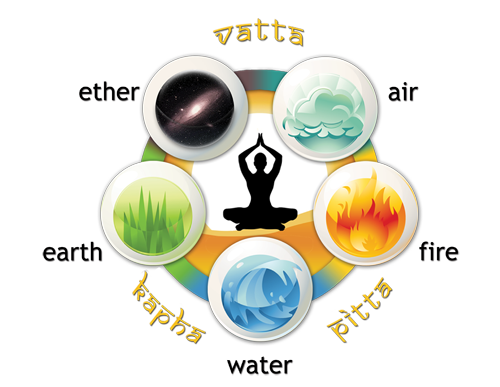
The five fundamental elements of Ayurveda are called “Panchamahabhuta” and are named Vayu (air), Jal (water), Agni (fire), Bhumi (earth), and Aakash (space/ether).
The Panchamahabhuta combine various ratios and methods to produce different and distinctive forms of matter.
FIVE ELEMENTS:
| MAHABHUTA | PROPERTIES | SENSE ORGAN ASSOCIATION |
| Akash | Empty area of cosmos, frictionless, | Ear |
| Vayu | Light, subtle, touch | Skin |
| Agni | Energy, transformation, ageing, warmth, vision | Eyes |
| Jal | Fluidity, motion, taste | Tongue |
| Prithvi | Solidity, grouding forces, smell | Nose |
1-The sky and ether akash are not the same thing. It might resemble anything in space. Space or ether is represented by all of the body’s pores, channels, or empty spaces.
2-The fluid and dynamic gaseous form of substance are called air. Anything that is transported or moves conceptually does so as a result of this Mahabhuta. This Mahabhuta is a critical component of the Vata dosha, which governs movements in living things like those caused by motor or sensory nerve impulses, food passing through the gut, joint movements, etc.Following Akash in the order of creation is Vayu, or air.
3-Fire can change any substance’s condition. Agni Mahabhuta is the main component of Pitta dosha, the biological humor, in living things.
It causes the metamorphosis of living things. This Agni provides the energy needed for every bodily function.
Energy can be changed from one form to another but cannot be created or destroyed. The food we consume provides us with energy, and biological Agni converts the energy in the food into energy that our cells can use.
This Agni bio transforms the nutrients we consume, such as vitamins, minerals, carbs, and fats, into forms our bodies can use. As long as this Agni is balanced, all bodily functions run well.
Any disruption of this Agni leads to an imbalance in homeostasis and impairs operation.
The basic foundation of Ayurvedic medicine is the idea of Agni. “Kaya chikitsa” refers to the branch of Ayurveda that focuses on internal medicine and treatment, where Kaya stands for Agni and Chikitsa stands for care. Ayurvedic therapeutics focuses on the rectification and maintenance of biological Agni.
4-Water symbolizes the liquid state. Our blood, lymph, and other fluids bring energy, carry away wastes, regulate temperature, bring disease-fighters, and carry hormones from one area to another.
Evolution of Aapamahabhoota follows that of Agni Mahabhuta. Sense of taste (Rasa) is its chief sense attribute, and liquidity (DraVatawa) is the leading property. Apa Mahabhuta is the main constituent of the biological humor Kapha dosha. This Mahabhuta brings and keeps things together. Conceptually all biological and chemical are feasible because of this Mahabhuta.
5-Earth represents the solid state of matter and symbolizes stability, permanence, and rigidity. In our body, the parts such as bones, teeth, cells, and tissue indicate earth elements. The last in the series to evolve is Prithvi Mahabhuta. Sense of smell (Gandha) is its main sense attribute, and Roughness (Kharatwa) is its basic property.
These five elements are the basic building blocks of matter and are combined in an infinite variety of relative proportions so that each form of matter is unique. Each element has a variety of attributes, only some get apparent in particular situations.
BODY AND PANCHAMAHABHUTA
| DOSHA | QUALITIES |
| VATTA | Enthusiasm Inspiration Initiation and Execution Proper functioning of sense organ |
| PITTA | Attends digestion Maintains body temperature Vision Appetite Thirst Complexion Intelligence Courage Valour Suppleness in body |
| KAPHA | Counters stability Lubrication Compactness of joints Capacity to hold emotions and mental stress |
These five elements combine in a special way to form a single living cell; the earth element gives the cell structure. The cytoplasm, or liquid inside the cell membrane, contains the element water. The fire element is represented by the metabolic activities taken on inside the cell.
The exchange of gases is a representation of the air element.
The area that the cell occupies represents the ether or space element.
The space element is indicated by the holes or channels that allow nutrients to enter the cell and waste metabolic products to be expelled.
- Spaces within the body (mouth, nostrils, abdomen, etc.) in a complex, multicellular organism, like a human, signify the ether or space element, whereas gases and impulses or motions signify the air element.
- The fire element is indicated by the way enzymes work (intelligence, digestion, metabolism);
- The water element is present in all bodily fluids, including saliva, digestive secretions, and plasma;
- The earth element represents the body’s solid structure, including its bones, teeth, skin, and hair.
The tridosha theory serves as the cornerstone of ayurvedic therapy. It is founded on logic and is the most straightforward approach to comprehending the intricate workings of the human body. The finest aspect is that it can direct your decisions based on your Prakriti regarding your diet, lifestyle, and even your desired line of work.
Not just ayurvedic medical practitioners should be able to understand Ayurveda as a whole.This is because it is the science of daily life.
The Panchamahabhuta, or the five major elements, are regarded as the building blocks of the universe and are Akasha (space), Vayu (air), Agni (fire), Jala (water), and Prithvi (earth). Simply put, the five elements can be used to classify all matter in a way that is similar to how each element is organized on the periodic table
The body’s three humors or forces, known as the tridoshas, promote health when they are balanced and disease when out of it.
Vata, Pitta, and Kapha are the three doshas. For the best possible operation of the human body, the doshas ensure that all of the mahabhutas are held together and perform their tasks in harmony.
These are the forces or energies that the body uses to keep itself in a state of homeostasis.
Akasha and Vayu mahabhuta are held together by vata. Agni and Jala mahabhuta are held together by Pitta. Prithvi and Jala mahabhuta are held together by the power of kapha.
Vata:
Vata ensures that there are no impediments in the way of your body’s natural motions. This comprises breathing, musculoskeletal movements, nervous system conduction, cell ion exchange, and excretions.
Pitta:
Pitta is equally significant in balancing the water’s and fire’s diametrically opposed properties. Like an acid, which burns yet are fluids in its existential state. Pitta governs this principle in the body.
It causes transformation, serves heat energy, and breaks down food at cellular and gross levels. It gives the body warmth, vision, and color.
Kapha:
The unfavorable components of Jala and Prithvi are held together by the unifying and lubricating power of kapha. Consider combining stone with water. The body is stabilized by kapha force, and its structures are solidly supported by its muscles, tendons, ligaments, and fats.
Additionally, it creates fluid shock absorbers and protective coatings for the joints, brain, and spinal cord (CSF).
| DOSHA | MAHABHUTA | EFFECT |
| Vata | Akash and Vayu | Prana-Inspiration |
| Pitta | Agni and Jala | Teja- Transformation |
| Kapha | Prithvi and Jala | Oja-Immunity |
Can You Physically See Ayurvedic Doshas?
According to Ayurveda, Vata, Pitta, and Kapha rarely behave as matter but rather as energies. The amount of Pitta and Kapha in the body has been mentioned by the writers of some classical writings, but Vata has never been discussed.
Vata-Pitta-Kapha is consistently evaluated qualitatively rather than numerically in practice. This is a crucial aspect and the main justification for why, contrary to Hippocrates, blood (Rakta) is not regarded as the fourth humor.
